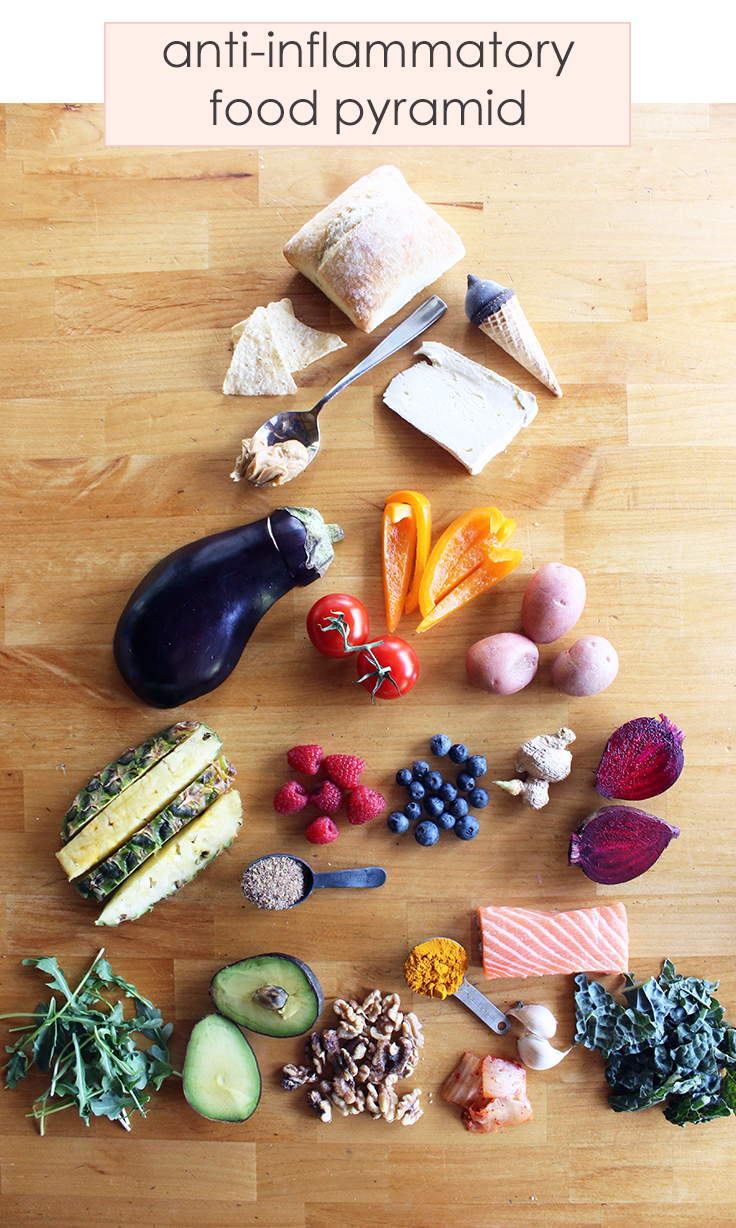Anti-Inflammatory Food Pyramid
I haven't talked about it too much here, but I suffer from the auto-immune disease, psoriasis. It actually started about 12 years ago, just weeks into living in New York. For the first 10 years it was really manageable, and I didn't think about it too much. I applied a topical steroid once a day, and visited my dermatologist about three to four times a year. I am not sure what the catalyst was, but about two years ago, the psoriasis flared up, and it was probably 10 times worse than it had ever been before that. For the past two years I have been searching for something to help and if it's natural, that is even better!
I am happy to report that in the past few weeks my patches are more clear than they have looked in years! I began light therapy treatments a few weeks back, basically a tanning booth you go in for a minute or two at a time that emits UVB rays. So I am not sure if it's the treatments, a change in environment, a reduction of stress, adjustments in my diet, or a combination, but whatever it is, it's working. And the diet is what I'm going to talk about today.
When I asked my dermatologists if there were changes in my diet I could make to help, they generally told me that there aren't any changes that have been proven to help. Then when I saw a naturopath, she suggested I try the GAPS Diet. I intimidated just reading about the GAPS Diet! So, I did some research to find something that could help and also fit my life. Enter the anti-inflammatory diet.
I based my pyramid off the one I found here, advised by nutritionist Barbra Mendez. I thought eating an anti-inflammatory diet was all about adding turmeric to everything, but it turns out there are a lot of delicious things you could be eating to help combat inflammation, and of course there are foods we all love (cheese and bread) that are no-nos.
PYRAMID BASE: GREENS AND HEALTHY FATS
The most important food for lowering inflammation? Leafy greens and cruciferous veggies, Mendez says. In her opinion, the more spinach, broccoli, romaine, cabbage, collard, and kale, the better. The reason? Greens are loaded with antioxidants, which rejuvenate weak cells, she says.
Besides leafy greens, the most powerful inflammation-fighting foods are salmon, walnuts, fermented foods, like kimchi, garlic, and yes, turmeric. Ideally, you want a serving of fermented foods and walnuts every day,. Because salmon can contain mercury, limit it to two servings a week.
Adding garlic and turmeric into your cooking and juices is a good way to incorporate into your diet. Here is a recipe for turmeric oil I found.
SECOND LEVEL: DOUBLE DUTY VEGGIES & FRUITS
Bromelain, an enzyme in pineapple and papaya, is both an inflammation-fighting agent and digestive aid, one serving of either fruit per day is recommended, in addition to a serving of berries per day. Incorporate beets, sweet potato and squash into bowls or salads two to three times a week—like greens, they help repair damaged cells.
And if you’re serious about addressing inflammation, Mendez recommends drinking two to three cups of ginger tea a day and incorporating flax oil into a daily salad or smoothie.
THIRD LEVEL: AVOID NIGHTSHADES
Nightshades are specific set of flowering fruits and vegetables that can be tough to digest, especially for those of us with autoimmune diseases. Tomatoes, peppers, eggplant and potatoes are all nightshades and should be avoided. Good bye salsa (but hello guac!).
TOP LEVEL: INFLAMMATION NEMESES
As you can expect, the most important foods to avoid include gluten, dairy, sugar and processed foods, as well as corn and peanut butter, and meat that you don't know where it comes from, AKA full of hormones. All the fun stuff, right?
The thing I love about this system is that it's not a rigorous diet, it's a guide line. Stress is a trigger for autoimmune diseases, so stressing over what to eat defeats the point. Trust me, I've been down that road before.
Here's how I've been adapting my diet to align more closely with this pyramid: I have been incorporating greens into as many meals as possible, my morning smoothie, a bowl or salad at lunch and a green salad with dinner. I've taken to kimchi or kombucha as an afternoon snack. I add nuts and avocado to my salads and I do my best to avoid the top two levels when I cook at home, but when I eat out, I give myself grace and allow myself to indulge, because it's all about balance, right?
Do you like this kind of content here? Should I share some of the recipes I've been trying?

